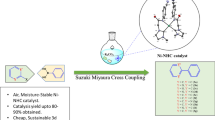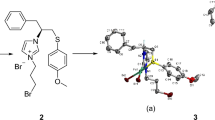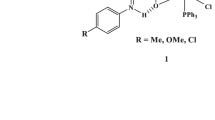Abstract
3-Aminoquinazolinone–phosphine proligands (5a–e) and their Ru(II) complexes (6a–e) were prepared and characterized by NMR (1H, 13C, 31P{1H}), FTIR and microanalysis. The 3-aminoquinazolinone–phosphine ligands were found to coordinate with the Ru(II) center via their phosphorus and nitrogen atoms. The Ru(II) complexes were applied as catalysts for the hydrogenation and transfer hydrogenation of prochiral ketones. The results showed that these complexes are efficient transfer hydrogenation catalysts.



Similar content being viewed by others
Change history
20 February 2018
In the initial online publication, there was a mistake in the title. The first words read “3-Aminoquinazolinone–phosphine” instead of “3-Aminoquinazolinone–phosphine”. The original article has been corrected.
References
Raja MU, Sindhuja E, Ramesh R (2010) Arene ruthenium(II) p-chloroacetophenone phenylthiosemicarbazone complex mediated transfer hydrogenation of ketones. Inorg Chem Commun 13:1321–1324
Keleş M, Şahinoğlu C, Emir DM, Mart M (2014) New iminophosphine-Ru(II) complexes and their application in hydrogenation and transfer hydrogenation. Appl Organometal Chem 28:768–772
Ohkuma T (2010) Asymmetric hydrogenation of ketones: tactics to achieve high reactivity, enantioselectivity, and wide scope. Proc Jpn Acad Ser B 86:202–219
Madern N, Talbi B, Salmain M (2013) Aqueous phase transfer hydrogenation of aryl ketones catalysed by achiral ruthenium(II) and rhodium(III) complexes and their papain conjugates. Appl Organometal Chem 27:6–12
Doucet H, Ohkuma T, Murata K, Yokozawa T, Kozawa M, Katayama E, England AF, Ikariya T, Noyori R (1998) Trans-[RuCl2(phosphane)2(1,2-diamine)] and chiral trans-[RuCl2(diphosphane)(1,2-diamine)]: shelf-Stable Precatalysts for the rapid, productive, and stereoselective hydrogenation of ketones. Angew Chem Int Ed 37:1703–1707
Mizushima E, Ohi H, Yamaguchi M, Yamagishi T (1999) Asymmetric transfer hydrogenation of aryl-alkyl ketones catalyzed by ruthenium (II) complexes having chiral pyridylmethylamine and phosphine ligands. J Mol Catal A: Chem 149:43–49
Gao JX, Ikariya T, Noyori R (1996) A ruthenium(II) complex with a C2-symmetric diphosphine/diamine tetradentate ligand for asymmetric transfer hydrogenation of aromatic ketones. Organometallics 15:1087–1089
Balakrishna MS, Panda R, Smith DC, Klaman A, Nolan SP (2000) Ruthenium(II) chemistry of phosphorus-based ligands, Ph2PN(R)PPh2 (R = Me or Ph) and Ph2PN(Ph)P(E)Ph2 (E = S or Se). Solution thermochemical study of ligand substitution reactions in the Cp’RuCl(COD) (Cp’ = Cp, Cp*; COD = cyclooctadiene) system. J Organomet Chem 599:159–165
Warton WL, Tanaka S, Hauser CMS, Öztopcu Ö, Hsieh JC, Mereiter K, Kirchner K (2010) Synthesis and characterization of ruthenium p-cymene complexes bearing bidentate P–N and E–N ligands (E = S, Se) based on 2-aminopyridine. Polyhedron 29:3097–3102
Ohkuma T, Ooka H, Hashiguchi S, Ikariya T, Noyori R (1995) Practical enantioselective hydrogenation of aromatic ketones. J Am Chem Soc 117:2675–2976
Ohkuma T, Koizumi M, Doucet H, Pham T, Kozawa M, Murata K, Katayama E, Yokozawa T, Ikariya T, Noyori R (1998) Asymmetric hydrogenation of alkenyl, cyclopropyl, and aryl ketones. RuCl2(xylbinap)(1,2-diamine) as a precatalyst exhibiting a wide scope. J Am Chem Soc 120:13529–13530
Noyori R, Koizumi M, Ishii D, Ohkuma T (2001) Asymmetric hydrogenation via architectural and functional molecular engineering. Pure Appl Chem 73:227–232
Noyori R, Ohkuma T (2001) Asymmetric catalysis by architectural and functional molecular engineering: practical chemo- and stereoselective hydrogenation of ketones. Angew Chem Int Ed Engl 113:40–73
Catir M, Cakici M, Karabuga S, Ulukanli S, Sahin E, Kilic H (2009) Synthesis of 4,4′-biquinazoline alcohols as chiral catalysts in enantioselective alkynylation of aldehydes with phenyl acetylene. Tetrahedron Asymmetry 20:2845–2853
Atkinson RS, Kelly BJ, Williams J (1992) Amination with 3-acetoxyaminoquinazolin-4-(3 h)ones: preparation of α-aminoacid esters by reaction with silyl ketene acetals followed by NN bond cleavage. Tetrahedron 48:7713–7730
Sehemi AGA, Atkinson RS, Fawcett J, Russell DR (1998) Stereoisomerism in 3-[N-(2-acetoxypropanoyl)-N-acylamino]quinazolin-4(3H)-ones, enantioselective acylating agents. J Chem Soc Perkin Trans 1:4413–4421
Davies DL, Duaij OA, Fawcett J, Giardiello M, Hilton ST, Russell DR (2003) Room-temperature cyclometallation of amines, imines and oxazolines with [MCl2Cp*]2(M = Rh, Ir) and [RuCl2(p-cymene)]2. Dalton Trans 21:4132–4138
Aydemir M, Baysal A, Özkar S, Yıldırım LT (2011) Trans- and cis-Ru(II) aminophosphine complexes: syntheses, x-ray structures and catalytic activity in transfer hydrogenation of acetophenone derivatives. Inorg Chim Acta 367:166–172
Malešević N, Srdić T, Radulović S, Sladić D, Radulović V, Brčeski I, Anđelković K (2006) Synthesis and characterization of a novel Pd(II) complex with the condensation product of 2-(diphenylphosphino)benzaldehyde and ethyl hydrazinoacetate. Cytotoxic activity of the synthesized complex and related Pd(II) and Pt(II) complexes. J Inorg Biochem 100:1811–1818
Sehemi AGA, Atkinson RS, Fawcett J, Russell DR (2000) 3-(N, N-Diacylamino)quinazolin-4(3H)-ones as enantioselective acylating agents for amines. Tetrahedron Lett 41:2239–2242
Barandov A, Abram U (2009) Heterofunctionalized phosphines derived from (2-formylphenyl)diphenylphosphine and their reactions with oxorhenium(V) complexes. Polyhedron 28:1155–1159
Pelagatti P, Bacchi A, Carcelli M, Costa M, Fochi A, Ghidini P, Leporati E, Masi M, Pelizzi C, Giancarlo PG (1999) Palladium(II) complexes containing a P, N chelating ligand: part III. Influence of the basicity of tridentates hydrazonic ligands on the hydrogenating activity of unsaturated C–C bonds. J Organomet Chem 583:94–105
Kwong HL, Cheng LS, Lee WS (1999) Enantioselective palladium catalyzed allylic substitution using chiral P, N, O Schiff base ligands. J Mol Catal A: Chem 150:23–29
Lee CC, Chu WY, Liu YH, Peng SM, Liu ST (2001) Coordination and catalytic activity of ruthenium complexes containing tridentate P, N, O ligands. Eur J Inorg Chem 31:4801–4806
Dai H, Hu X, Chen H, Bai C, Zheng Z (2004) New chiral ferrocenyldiphosphine ligand for catalytic asymmetric transfer hydrogenation. J Mol Catal A 209:19–22
Ohkuma T, Utsumi N, Tsutsumi K, Murata K, Sandoval C, Noyori R (2006) The hydrogenation/transfer hydrogenation network: asymmetric hydrogenation of ketones with chiral η6-arene/N-tosylethylenediamine-ruthenium(II) catalysts. J Am Chem Soc 128:8724–8725
Armarego WLE, Chai CLL (2003) Purification of laboratory chemicals, 5th edn. Pergamon Press, Oxford
Laue L, Greiner L, Wöltinger J, Liese A (2001) Continuous application of chemzymes in a membrane reactor: asymmetric transfer hydrogenation of acetophenone. Adv Synth Catal 343:711–720
Acknowledgements
This work was supported by the Osmaniye Korkut Ata University and the Scientific and Technological Research Council of Turkey (Project Number: 109T801). The authors also thank to Prof. Dr. Sabri Ulukanlı for the synthesis of 3-aminoquinazolinones.
Author information
Authors and Affiliations
Corresponding author
Additional information
A correction to this article is available online at https://doi.org/10.1007/s11243-018-0218-4.
Rights and permissions
About this article
Cite this article
Yılmaz, M.K., Keleş, M. 3-Aminoquinazoline–phosphine ligands and their ruthenium(II) complexes: application in catalytic hydrogenation and transfer hydrogenation reactions. Transit Met Chem 43, 285–292 (2018). https://doi.org/10.1007/s11243-018-0213-9
Received:
Accepted:
Published:
Issue Date:
DOI: https://doi.org/10.1007/s11243-018-0213-9




